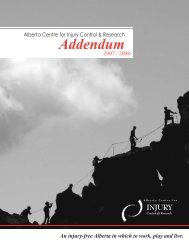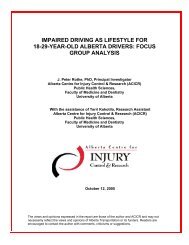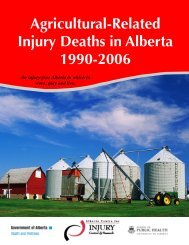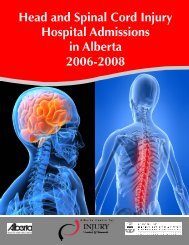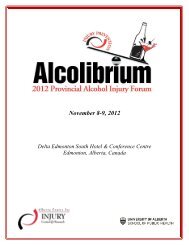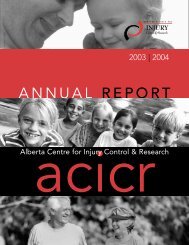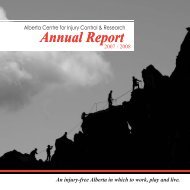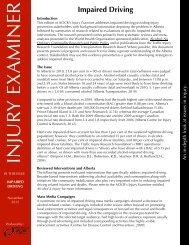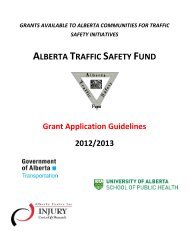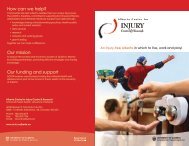JUNE 2003 - Alberta Centre for Injury Control & Research
JUNE 2003 - Alberta Centre for Injury Control & Research
JUNE 2003 - Alberta Centre for Injury Control & Research
You also want an ePaper? Increase the reach of your titles
YUMPU automatically turns print PDFs into web optimized ePapers that Google loves.
APPENDIX B<br />
Injuries know no boundaries. Data from other jurisdictions indicate that the<br />
injury problem is widespread. Injuries are considered a major public health<br />
epidemic nationally and internationally.<br />
United Kingdom<br />
The United Kingdom, in their report Preventing Accidental <strong>Injury</strong> -Priorities<br />
<strong>for</strong> Action; 12 state that injury is the leading cause of death among children<br />
aged 0-14 years. Falls (62%), road traffic accidents (12%) fire (3%) and<br />
suffocation (3%) cause the largest number of fatal injuries in older people. Of<br />
the accidental deaths that occurred in the home in 1999, half were working<br />
adults aged 15-64 years. Further the burden of accidental death is heaviest<br />
among the disadvantaged with residential fire deaths (15 times greater) and<br />
child pedestrian deaths (five times greater) being significantly higher. The<br />
estimated cost of injury deaths and morbidity, including poisoning and<br />
intentional injury, to the National Health Service was 2.2 billion pounds in<br />
2000-01. Consequently the Task Force recommended some immediate<br />
priorities <strong>for</strong> action: priority populations being children and young people<br />
and older people; and priority injury areas being falls at or near home, road<br />
accidents, dwelling fires and play and recreation. Specific attention was also<br />
recommended to those persons within the above priorities who are<br />
disadvantaged. Longer-term priorities included young car drivers and<br />
passengers, sports injuries, injuries at work and home and leisure injuries.<br />
The recommendations included a coordinated approach across government<br />
and the National Health System, with regional coordination of delivery of the<br />
strategies recommended <strong>for</strong> accidental injury prevention.<br />
Australia<br />
In Australia, a similar situation is also reported. The Department of Health<br />
and Aged Care in the Commonwealth of Australia in a document entitled<br />
National <strong>Injury</strong> Prevention Plan, Priorities <strong>for</strong> 2001-<strong>2003</strong> and the<br />
Implementation Plan, 13 state that injuries remain a leading cause of death,<br />
illness and disability in Australia, despite dramatic advances in road safety<br />
over the past two decades and despite improvements in occupational and<br />
clinical care. Indigenous Australians, young men, and people who live in<br />
rural and remote areas are at particularly high risk of injury. Injuries are the<br />
leading cause of premature, preventable death and account <strong>for</strong> 47% of all<br />
deaths under age 45 years. The cost to the nation is estimated to be over 23<br />
billion dollars per year. A National <strong>Injury</strong> Prevention Advisory Council<br />
(NIPAC) was established and identified four priority areas <strong>for</strong> immediate<br />
action: falls in older people, falls in children, drowning and near drowning<br />
and poisoning in children. While road crashes and other transport accidents<br />
as well as suicide and self-inflicted injuries are major causes of injury, they<br />
were ruled out as immediate priorities due their assessment criteria <strong>for</strong><br />
establishing priorities. In the latter injury areas other national organizations<br />
Making <strong>Alberta</strong> the Safest Place to Live<br />
59



